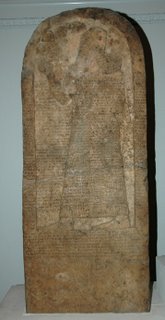Breakfast, beans, and the British Museum
Day 1, Heathrow airport, London – I landed in London after the 7.5 hour flight from Chicago. Boy those British Airways seats are small. I think I was touching one of the men on either side of me for the whole flight. Yuck! I actually did get some sleep though, so I was able to hit the ground running. A friend met me at the airport and we headed into town for a typical English breakfast.
OK, for those of you who don’t know this, breakfast is my favorite meal of the day. So I thought, OK I’ll give the English a chance to wow me with their morning delights. I ordered the “Full English” and it came with one over-easy egg, three grilled tomato slices (!), one large sausage, four pieces of grilled ham strips, two slices of toast and beans! The beans were disappointing. I guess I expected something more done up. It looked liked they had opened a can of generic “baked beans” warmed them up and splashed them on the plate! My friend, perhaps wanting to make sure I had the “Full-Full English”, offered me a taste of his “black pudding”. Why is it black? It’s made with pigs blood! I had two bites. I felt unclean. I hope they let me into Israel. After cleaning my plate, I had a sugar craving and I went looking for the pancakes only to realize that to get those you have to order the “American Breakfast”. You get hash browns with that too. Oh well that was my last chance to have something decent for breakfast for three weeks. Believe me you’ll hear about this issue again.
After that we headed for the British Museum. Finally, after studying ancient Near Eastern Antiquities for years I had a chance to see some of the more dramatic archaeological finds ever uncovered. The museum has what is arguably the best collection of antiquities related to the Bible in the world under one roof. Knowing about some of these discoveries can be very helpful for students of the Bible. For example, have you ever wondered if the Bible gets its historical details right? Have you ever wondered if there are any hard facts which demonstrate that the writers of the Bible knew the details of the history they were writing? Let's face it lot of people criticize the Bible as being full of historical errors. Fear not, those hard facts do exist! I saw a bunch of them today at the British Museum. I’ll highlight one.
The northern kingdom of Israel and Aram (Syria) were mortal enemies for much of the 9th century B.C. (899-800). They fought many battles some of which are recounted in 1-2 Kings. In 1 Kings 22 we discover that there was a period of three years when Israel and Aram were at peace. After those three years Ahab, king of Israel attacked Aram at Ramoth-Gilead and was mortally wounded. We should ask the question: Why was there peace for three years? And why did hostilities resume? The answer can be found on the The Kurkh Monolith of  Shalmaneser III which is in the British Museum (see picture). The inscription on the stone describes a battle the Assyrian king, Shalmaneser, fought against a coalition of nations from Syria/Palestine in 853 B.C. . Among the coalition members facing him in battle were Adad-idri of Aram and Ahab of Israel! That's right the inscription mentions Ahab by name. It also notes that Ahab contributed 2,000 chariots and 10,000 soldiers to the war effort. That’s a significant amount of chariots! Now the inscription says that Shalmaneser routed this coalition, but the reality is that the battle ended in a stalemate. The small western states succeeded in stopping the Assyrian juggernaut! OK, why is this important? Well, this event IS NOT mentioned in the Bible, but it helps explain why Israel and Aram were peaceable with each other for three years as recorded in 1 Kings 22. They were friends because they needed each other to stop Shalmaneser. They had bigger fish to fry! It does no good to be fighting with people who could be your allies. Now, after Shalmaneser had been defeated in 853, all pretences of friendship were dropped; Israel and Aram picked up right where they left off. Remember the Kurkh Monolith of Shalmaneser III it helps support the Bible.
Shalmaneser III which is in the British Museum (see picture). The inscription on the stone describes a battle the Assyrian king, Shalmaneser, fought against a coalition of nations from Syria/Palestine in 853 B.C. . Among the coalition members facing him in battle were Adad-idri of Aram and Ahab of Israel! That's right the inscription mentions Ahab by name. It also notes that Ahab contributed 2,000 chariots and 10,000 soldiers to the war effort. That’s a significant amount of chariots! Now the inscription says that Shalmaneser routed this coalition, but the reality is that the battle ended in a stalemate. The small western states succeeded in stopping the Assyrian juggernaut! OK, why is this important? Well, this event IS NOT mentioned in the Bible, but it helps explain why Israel and Aram were peaceable with each other for three years as recorded in 1 Kings 22. They were friends because they needed each other to stop Shalmaneser. They had bigger fish to fry! It does no good to be fighting with people who could be your allies. Now, after Shalmaneser had been defeated in 853, all pretences of friendship were dropped; Israel and Aram picked up right where they left off. Remember the Kurkh Monolith of Shalmaneser III it helps support the Bible.
OK time to go, less than an hour until departure. Final destination tomorrow Jerusalem, the Old City.

0 Comments:
Post a Comment
<< Home